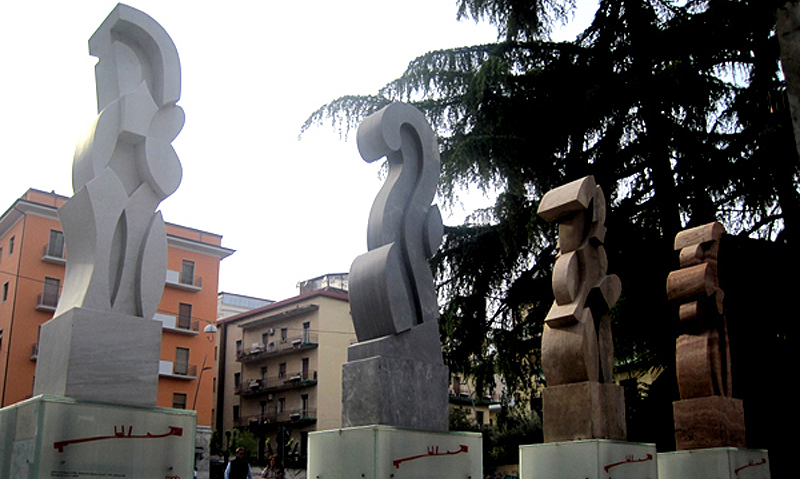Invasioni Digitali ~ Cosenza: Tra Monumentalismo e Razionalismo
The Invasioni Digitali this year were a blast! Last year, the digital invasion of Cosenza focused on the historic center but this year it was centered on the more modern elements of the city. And, seeing as it was April 25th, Liberation Day, we also looked at some of the remnants of the Fascist Era present throughout city.
As I approached the meeting point, I could see a large group of people had already begun to form in front of the City Hall where our guide, Alessandra Scanga of GuideOnCosenza was waiting. It wasn’t long before we were off to invade Cosenza equipped with our mobiles, cameras, and tablets.
Here is a look at some of the places we visited during the invasion!

Piazza Bruzi: City Hall of Cosenza
The Elmo Arcaico (Bretio) has been sitting in front of Cosenza’s city hall since it was installed in 1996. Created by painter/sculpture Mimmo Paladino in 1948, this bronze helmet sitting on a black marble fountain appears to be floating on a bed of water.

Piazza E.Cenisio: Chiesa di San Nicola
The Chiesa di San Nicola is located in the city center of Cosenza at Piazza E. Cenisio. This church is more modern than its neighbour, Il Duomo, located across the river in the old center of Cosenza. The original Chiesa di San Nicola was built in the 1600s in another part of the city . Like many buildings in this city, it suffered incredible damage during the earthquake of 1783 and again in 1943 during WWII. In 1961, the church was demolished and the “new” church was relocated and rebuilt in a more contemporary style.

Piazza Francesco Crispi: La Fontana del Balilla & Le Poste Vecchie
This piazza is home to La Fontana del Balilla, a white marble fountain built in the first decade of the Fascist period. The figure of Balilla, the Genoese boy who provoked an uprising against the Austrians in 1746 by throwing a rock at an Austrian official, stands dominantly atop the fountain as a symbol of the Italian people’s struggle for independence and unification. Behind the fountain, the historic post office known as Le Poste Vecchie stands tall.

INCIS, Steps of Via Isonzo
In and around the area of Piazza Cappello and The Chiesa di Santa Teresa are homes that were built by INCIS, an institute created during the Fascist Era to build “case poplari” (houses for the poor). Some of the buildings still have the insignia on them.

Piazza Cappello: Ex-Palazzo & Piazza del Littorio
On March 30th, 1939, Mussolini came to Cosenza to this very square, now known as Piazza Cappello. There are many old photos showing Mussolini standing on the balcony of the building, known as “Casa Littora” at the time, overlooking the square. Also in the square, is this interesting iron and glass sculpture entitled “A Tre Mani” (Three Hands) created by Silvio Vigliaturo.

Chiesa di Santa Teresa
Built in the 20th century, this church overlooks a large square. The church, originally designed in the Gothic style, began construction in 1929 before it was halted in the early part of the 1930s. In 1954, work resumed but with a new design in mind, that of a Romanesque building which was eventually finished in 1978.

The Paracarri & Fontane musicali, Via Arabia
Atop the stairs of Via Arabia lie the “Paracarri” by Pietro Consagra, the perfect topper to the enchanting musical fountain located in the centre of Cosenza’s pedestrian street, Corso Mazzini. It’s hard not to be drawn into the music and playfulness of the dancing water works.
If you want to see more of my pics from the day, head on over to the Calabrisella Mia Facebook Page. For pics from other invaders, type these hashtags (#ScoprilaCalabria #GuideOnCosenza #InvasioniCosenza #InvadiCosenza) into Instagram, Twitter and/or Facebook.
A very special thank you has to go out to the wonderful organizers of this year’s event:
Associazione Culturale Scopri la Calabria
GuideOnCosenza Alessandra Scanga (Tour Guide)
Looking forward to next year! 🙂
